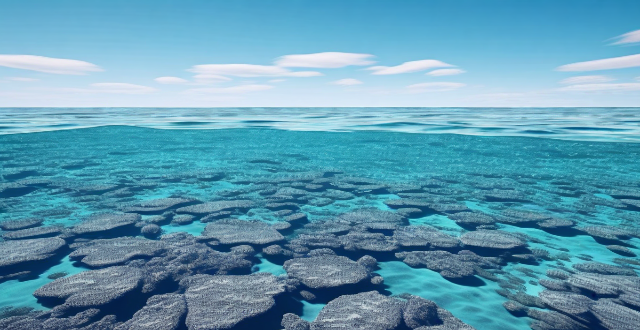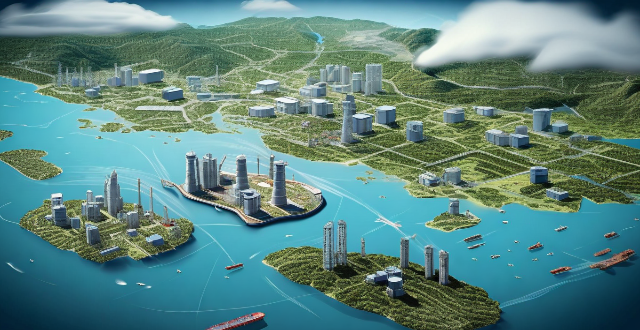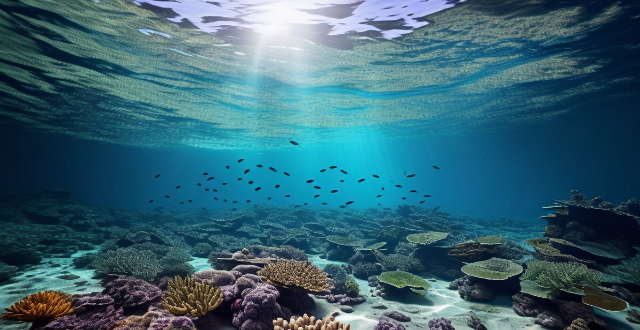Global Habitat

How is global warming impacting biodiversity and endangered species ?
Global warming is impacting biodiversity and endangered species through habitat loss, changes in weather patterns, and increased disease outbreaks. Habitat loss occurs as species are forced to migrate due to rising temperatures, leading to competition for resources and loss of habitats. Changes in weather patterns cause extreme events like droughts, floods, and storms, disrupting ecosystems and potentially leading to species extinction. Additionally, global warming contributes to the spread of diseases among wildlife populations, posing a threat to endangered species. It is crucial to take action to mitigate the effects of global warming and protect vulnerable populations.

What is the relationship between climate change and loss of habitat for endangered species ?
Climate change is causing significant changes in ecosystems around the world, leading to the loss of habitat for endangered species. Rising temperatures, changing precipitation patterns, sea level rise, and extreme weather events are all factors that contribute to this loss. Endangered species are particularly vulnerable to these changes due to their small populations and limited ranges. Examples of endangered species affected by climate change include polar bears, giant pandas, leatherback turtles, and amphibians. It is essential that we take action to protect these species and their habitats, including reducing greenhouse gas emissions, conserving natural habitats, and developing adaptation strategies.

What are the potential long-term effects of global warming on ecosystems ?
Global warming, caused by greenhouse gases, can have severe impacts on ecosystems worldwide. Potential long-term effects include species extinction, changes in distribution and abundance of species, alteration of ecosystem functions, loss of habitat due to rising sea levels, and invasion of non-native species. These impacts underscore the need for action to mitigate climate change and protect ecosystems.

What are the impacts of global warming on marine life and fish populations ?
The provided text discusses the impacts of global warming on marine life, particularly fish populations. It outlines how rising ocean temperatures alter habitats and affect metabolic rates; how ocean acidification disrupts calcification processes; how changes in currents and water circulation alter migration patterns and species ranges; the loss of coral reefs and its implications; the effects of extreme weather events on marine environments; and the challenges these changes present for resource management. The conclusion emphasizes the need for collective efforts to mitigate the effects of global warming on oceans.

What role does global warming play in climate predictions ?
The text discusses the role of global warming in climate predictions, emphasizing its multifaceted impact on various aspects of the Earth's climate system. Key points include increased temperatures leading to melting ice, rising sea levels, and changes in precipitation patterns; intensified extreme weather events like heat waves and hurricanes; ocean acidification harming marine life; alterations in ecosystems affecting animal migration and habitats; agricultural impacts such as changing crop yields and growing seasons; and human health concerns including the spread of diseases and heat-related illnesses. The conclusion stresses the importance of considering these factors in future climate projections and mitigating the effects of global warming through reduced greenhouse gas emissions.

Is geoengineering a viable solution to global warming ?
Geoengineering, also known as climate engineering or earth system management, refers to the intentional manipulation of the global climate on a large scale to counteract the effects of global warming and reduce the risks associated with climate change. While geoengineering has potential benefits such as mitigating climate change, providing faster responses compared to conventional methods, and being relatively inexpensive, it also comes with uncertainties regarding long-term effects, lack of international regulation and governance, and limited scope compared to other mitigation strategies. Therefore, geoengineering should not be seen as a substitute for conventional mitigation strategies but rather complement them. Extensive research and international cooperation are essential before implementing any large-scale geoengineering projects to ensure their safety and effectiveness in addressing climate change challenges.

What is the relationship between forest health and the global carbon cycle ?
The text discusses the relationship between forest health and the global carbon cycle. It highlights the importance of forests in absorbing carbon dioxide from the atmosphere and storing it in their biomass, which helps to mitigate the effects of climate change. Deforestation, or the clearing of forests for agricultural or urban development purposes, has a significant impact on the global carbon cycle by releasing carbon stored in trees back into the atmosphere as CO2. Healthy forests are more effective at sequestering carbon than degraded or damaged forests. Several strategies can be implemented to maintain the health of forests, including protecting existing forests, restoring degraded forests, promoting sustainable forestry practices, reducing emissions from deforestation and forest degradation, and increasing public awareness.

How do invasive species affect biodiversity ?
Invasive species can have a significant impact on native biodiversity, both positively and negatively. They can outcompete and replace native species, leading to changes in community structure and ecosystem function. Invasive species can also cause damage to infrastructure and human health through the spread of disease or destruction of habitats. Management strategies for invasive species include prevention measures such as quarantines and biosecurity protocols, as well as control measures such as eradication programs and habitat restoration. It is important to consider the costs and benefits of each strategy when developing a management plan.

What are the main threats to global biodiversity ?
The article discusses the main threats to global biodiversity, which include habitat loss and fragmentation due to urbanization, agricultural expansion, and mining and extraction; climate change with rising temperatures, altered precipitation patterns, and extreme weather events; pollution from chemicals, noise, and light; overexploitation through overfishing, hunting and poaching, and harvesting of plants; invasive alien species competing for resources, transmitting diseases, and altering habitats; and human population growth leading to increased consumption, waste production, and conflict with wildlife. These threats are interconnected and require coordinated efforts from various stakeholders to implement sustainable practices and protect our planet's diversity of life.

What is the impact of climate action on biodiversity and ecosystems ?
Climate action has both positive and negative impacts on biodiversity and ecosystems. Positive effects include reduction in greenhouse gas emissions, increased awareness and education, protection of key habitats, promotion of sustainable practices, and restoration of degraded ecosystems. Negative effects include displacement of local communities, habitat loss and fragmentation, ecosystem disruption, resource competition, and uncertain long-term outcomes. To maximize the benefits of climate action for biodiversity and ecosystems, an integrated approach that considers both environmental and social factors is crucial.

How can international cooperation on climate change contribute to global security ?
International cooperation on climate change is vital for global security. It helps mitigate environmental disasters, promotes economic stability and growth, enhances social cohesion and peace, facilitates technology and knowledge sharing, and strengthens global governance and diplomacy. Through joint efforts, nations can address one of the most pressing challenges of our time and secure a safer future for all.

How do invasive species interact with climate change to threaten native biodiversity ?
Invasive species and climate change pose significant threats to native biodiversity by exacerbating range expansion, altering competition, increasing predation pressure, degrading habitats, facilitating disease transmission, disrupting mutualisms, having synergistic effects, depleting resources, displacing keystone species, and reducing ecosystem resilience. Integrated management strategies are crucial for mitigating these threats and include habitat restoration, invasive species control, protection of keystone species, and conservation of diverse genetic pools within native species to enhance their adaptability.

What are the latest trends in the global economy ?
The global economy is influenced by various interconnected factors including digital transformation, sustainability, global trade dynamics, monetary policies, and the rising influence of emerging markets. These trends are reshaping industries, fostering innovation, and influencing economic growth and policies worldwide.

What is the relationship between ecological design and green roofs/walls ?
Ecological design emphasizes sustainability and harmony with the environment, incorporating green roofs/walls for energy efficiency, stormwater management, habitat creation, air quality improvement, and aesthetic enhancement. These features require careful consideration of climate, building structure, water management, maintenance, energy efficiency, and habitat connectivity to ensure their success and alignment with ecological design principles.

What are the impacts of global warming on ecosystems and species diversity ?
Global warming, primarily caused by human activities, significantly impacts ecosystems and species diversity. These effects include habitat loss, altered species interactions, the spread of invasive species, disease proliferation, ocean acidification, melting permafrost, changes in fire regimes, water stress, sea level rise, coral bleaching, increased extinction risk, shifting ranges, population declines, adaptation challenges, loss of genetic diversity, behavioral changes, phenological shifts, reproductive challenges, physiological stress, and disrupted mutualisms. Addressing these issues requires immediate action to reduce greenhouse gas emissions and adapt to the changing climate.

How do greenhouse gas emissions contribute to global warming ?
Greenhouse gas emissions, primarily carbon dioxide (Greenhouse gas emissions, primarily carbon dioxide (e (CH4), nitrous oxide (N2O), and fluorinated gases, play a crucial role in the phenomenon of global warming. These gases trap heat within the Earth's atmosphere, leading to an increase in the planet's average temperature. The greenhouse effect is a natural process where certain gases in the Earth's atmosphere trap energy from the Sun. However, excessive amounts of greenhouse gases due to human activities are causing this natural process to become unbalanced, resulting in global warming. The primary sources of these emissions include fossil fuel burning, deforestation, industrial processes, agriculture, and waste management. The increase in greenhouse gas concentrations leads to more heat being trapped within the Earth's atmosphere, causing a range of environmental impacts including melting ice caps and glaciers, extreme weather events, ocean acidification, and habitat loss. To combat the effects of greenhouse gas emissions and global warming, various strategies are being implemented, including renewable energy, energy efficiency, carbon capture and storage, reforestation, and sustainable agriculture.

How does climate variability affect global weather patterns ?
The impact of climate variability on global weather patterns is substantial, affecting temperature, precipitation, wind patterns, and extreme weather events. Key influences include El Niño and La Niña phases, monsoon systems, altered rainfall distribution, jet stream variations, tropical cyclones, heatwaves, cold spells, storms, floods, and droughts. Long-term climate trends like global warming also significantly affect weather patterns. Understanding these interactions is crucial for predicting future conditions and addressing climate-related challenges.

What is the relationship between the greenhouse effect and ice caps melting ?
The greenhouse effect, amplified by human activities, leads to global warming which causes ice caps to melt, leading to sea level rise, climate change, and ecosystem disruption.

How do climate data analysis contribute to understanding global warming ?
Climate data analysis is essential for understanding global warming, its causes, effects, and potential solutions. Scientists collect temperature records, carbon dioxide concentrations, and sea level data to identify trends, establish correlations, and create predictive models. These efforts help develop effective strategies to mitigate the impacts of global warming.

What role does natural gas play in the global energy market ?
Natural gas is a key player in the global energy market due to its environmental advantages, economic benefits, contributions to energy security, technological advancements, and versatile applications across sectors.

How does global shopping contribute to economy ?
Global shopping, or cross-border e-commerce, has become a crucial aspect of the global economy. It involves buying and selling goods and services across national borders through online platforms. This phenomenon has not only revolutionized shopping but also significantly contributed to economic growth worldwide. Here are some ways global shopping boosts the global economy: 1. Increased consumer spending: Global shopping provides consumers with access to a wide range of products from around the world, leading to higher consumer spending, which is a key driver of economic growth. 2. Benefits for sellers: Businesses can reach new customers and expand their market share by tapping into international markets, increasing revenue and profitability. 3. Job creation and employment opportunities: The rise of global shopping has given birth to numerous jobs in various sectors such as logistics, customer service, marketing, and technology. 4. Boosting local economies: Local businesses can reach customers beyond their geographical boundaries by exporting their products globally, generating revenue that helps sustain their operations and contribute to the local economy. 5. Encouraging innovation and competition: The global marketplace created by cross-border e-commerce encourages businesses to innovate and improve their products to stay competitive, benefiting consumers by providing them with high-quality products at competitive prices. 6. Fostering international trade relations: Global shopping promotes cooperation between nations by facilitating trade agreements and reducing barriers to entry for businesses looking to expand internationally.

What is the role of technology in improving global health outcomes ?
Technology plays a crucial role in improving global health outcomes through advanced medical equipment, digital health solutions, and more. It has revolutionized diagnosis, treatment, disease surveillance, prevention, accessibility, affordability of healthcare services, research and development initiatives, and health literacy and education. Technology's impact on global health will continue to grow positively as it evolves at a rapid pace.

How is climate change affecting global temperatures ?
Climate change, largely due to human activities like burning fossil fuels and deforestation, is causing a rise in global temperatures. This has led to more frequent and severe extreme weather events, melting ice caps, ocean warming and acidification, changes in precipitation patterns, impacts on biodiversity, and challenges for agriculture. The situation calls for immediate action to reduce greenhouse gas emissions and adapt to the changing climate.

How does global shopping affect local businesses ?
Global shopping has become increasingly popular due to the rise of e-commerce platforms and international shipping services. While it offers consumers a wider range of products and competitive prices, it also poses challenges for local businesses such as increased market competition, job displacement, cultural homogenization, environmental impact, intellectual property rights issues, and economic dependency. As consumers continue to embrace global shopping, it is crucial for local businesses to adapt and find ways to differentiate themselves in order to remain competitive and sustainable in the long run.

How does TCFD align with other global reporting initiatives like the Global Reporting Initiative (GRI) ?
The Task Force on Climate-related Financial Disclosures (TCFD) and the Global Reporting Initiative (GRI) are two global sustainability reporting frameworks that share several key points of alignment. Both provide guidelines for companies to report on their sustainability performance, with TCFD focusing specifically on climate-related financial disclosures and GRI covering a broader range of sustainability issues. They also emphasize the importance of materiality assessment, stakeholder engagement, risk management, and climate change disclosures in determining which aspects are most relevant to an organization's business model and strategy. By following both frameworks, companies can provide a more comprehensive picture of their sustainability performance and demonstrate their commitment to addressing climate change and other sustainability issues.

How do communication satellites improve global connectivity ?
Communication satellites play a crucial role in enhancing global connectivity by providing reliable and high-speed internet access to remote areas, facilitating international communication, and supporting various applications such as telemedicine, e-learning, and disaster management. They cover vast geographic areas, including mountainous regions, deserts, and oceans, where traditional infrastructure is not feasible or cost-effective. Satellite internet services can be deployed quickly, often within days or weeks, compared to months or years required for terrestrial networks. They enable seamless communication across national borders, fostering global cooperation and collaboration. Newer generations of low Earth orbit (LEO) satellites reduce latency by orbiting closer to Earth, improving the speed and quality of international communication. Satellites facilitate telemedicine by providing real-time video conferencing between patients and healthcare professionals located far apart. They enable e-learning by connecting students in remote areas with educational resources and teachers around the world. During natural disasters or crises, satellites provide critical communication channels for emergency response teams and affected communities.

What are the current global health challenges ?
The world is facing a multitude of health challenges that require immediate attention and action, including infectious diseases, non-communicable diseases, mental health issues, and environmental health hazards. Infectious diseases such as COVID-19, HIV/AIDS, tuberculosis, and malaria continue to be a major threat to global health. Non-communicable diseases like cardiovascular diseases, cancer, diabetes, and chronic respiratory diseases are becoming increasingly prevalent globally. Mental health disorders, including depression, anxiety disorders, and substance abuse, are a growing concern worldwide. Environmental factors such as air pollution, water pollution, climate change, and natural disasters also pose significant risks to human health.

Is global shopping more convenient than local shopping ?
Global shopping, also known as cross-border e-commerce, has become increasingly popular in recent years. It allows consumers to purchase products from different countries and have them delivered to their doorsteps. However, is it really more convenient than local shopping? This article explores the advantages and disadvantages of global shopping and concludes that whether it's more convenient depends on various factors such as product availability, pricing, delivery times, shipping costs, and customs duties. While global shopping offers a wider range of products and potentially lower prices, it also comes with longer delivery times, higher shipping costs, and potential additional charges like customs duties. Therefore, consumers should carefully consider these factors before deciding which option is most convenient for them.

How does environmental degradation affect global ecosystems ?
Environmental degradation affects global ecosystems in various ways, including loss of biodiversity, disruption of ecosystem services, changes in the carbon cycle, and impact on human health. It is crucial to take steps to mitigate environmental degradation and protect our planet's ecosystems for future generations.

What are the consequences of not addressing climate debt ?
Addressing climate debt is crucial to mitigate environmental degradation, social injustices, and economic instability. Failure to do so exacerbates global warming effects like loss of biodiversity, sea level rise, and extreme weather events. It also leads to inequality, health issues, food insecurity, economic downturn, investment risks, and job losses. Recognizing and addressing climate debt is essential for achieving global sustainability goals and ensuring peace and justice worldwide.